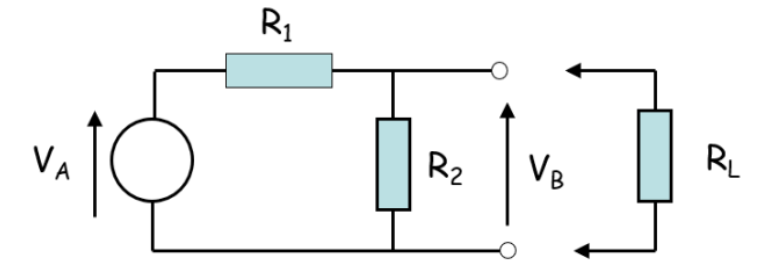Question 4: Potential divider circuit illustrated below. R₁ VA (i) (ii) (iii) R₂ VB J RL a) Show that Vв = (R₂ / (R₁ + R₂)) X VA b) How does VB change when a load R₁ is attached? c) It is required to provide a 1 V source from a 10 V power supply VA, using a 1k and a 9k resistor. How does Vв change when RL is; 100 ΚΩ 10 ΚΩ 1 kn
Question 4: Potential divider circuit illustrated below. R₁ VA (i) (ii) (iii) R₂ VB J RL a) Show that Vв = (R₂ / (R₁ + R₂)) X VA b) How does VB change when a load R₁ is attached? c) It is required to provide a 1 V source from a 10 V power supply VA, using a 1k and a 9k resistor. How does Vв change when RL is; 100 ΚΩ 10 ΚΩ 1 kn
Introductory Circuit Analysis (13th Edition)
13th Edition
ISBN:9780133923605
Author:Robert L. Boylestad
Publisher:Robert L. Boylestad
Chapter1: Introduction
Section: Chapter Questions
Problem 1P: Visit your local library (at school or home) and describe the extent to which it provides literature...
Related questions
Question

Transcribed Image Text:Question 4: Potential divider circuit illustrated below.
R₁
VA
How does Vв change when RL is;
100 ΚΩ
10 ΚΩ
1 kn
(i)
(ii)
R₂
VB
a) Show that VB = (R₂ / (R₁ + R₂)) x VA
b) How does VB change when a load R₁ is attached?
c) It is required to provide a 1 V source from a 10 V power supply VA, using a 1k2 and a 9k2 resistor.
RL
Expert Solution
Step 1: Stating the given data
Given circuit:

Step by step
Solved in 6 steps with 7 images

Knowledge Booster
Learn more about
Need a deep-dive on the concept behind this application? Look no further. Learn more about this topic, electrical-engineering and related others by exploring similar questions and additional content below.Recommended textbooks for you

Introductory Circuit Analysis (13th Edition)
Electrical Engineering
ISBN:
9780133923605
Author:
Robert L. Boylestad
Publisher:
PEARSON

Delmar's Standard Textbook Of Electricity
Electrical Engineering
ISBN:
9781337900348
Author:
Stephen L. Herman
Publisher:
Cengage Learning

Programmable Logic Controllers
Electrical Engineering
ISBN:
9780073373843
Author:
Frank D. Petruzella
Publisher:
McGraw-Hill Education

Introductory Circuit Analysis (13th Edition)
Electrical Engineering
ISBN:
9780133923605
Author:
Robert L. Boylestad
Publisher:
PEARSON

Delmar's Standard Textbook Of Electricity
Electrical Engineering
ISBN:
9781337900348
Author:
Stephen L. Herman
Publisher:
Cengage Learning

Programmable Logic Controllers
Electrical Engineering
ISBN:
9780073373843
Author:
Frank D. Petruzella
Publisher:
McGraw-Hill Education

Fundamentals of Electric Circuits
Electrical Engineering
ISBN:
9780078028229
Author:
Charles K Alexander, Matthew Sadiku
Publisher:
McGraw-Hill Education

Electric Circuits. (11th Edition)
Electrical Engineering
ISBN:
9780134746968
Author:
James W. Nilsson, Susan Riedel
Publisher:
PEARSON

Engineering Electromagnetics
Electrical Engineering
ISBN:
9780078028151
Author:
Hayt, William H. (william Hart), Jr, BUCK, John A.
Publisher:
Mcgraw-hill Education,